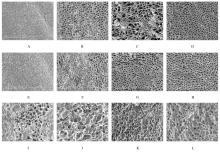| 1 |
UZUNOGLU-ÖZYÜREK E, ERDOĞAN Ö, TÜRKER S A. Effect of calcium hydroxide dressing on the dentinal tubule penetration of 2 different root canal sealers: a confocal laser scanning microscopic study[J]. J Endod, 2018, 44(6): 1018-1023.
|
| 2 |
CRUZ A T G, GRECCA F S, PIASECKI L, et al. Influence of the calcium hydroxide intracanal dressing on dentinal tubule penetration of two root canal sealers[J]. Eur Endod J, 2017, 2(1): 1-6.
|
| 3 |
AMIN S A W, SEYAM R S, EL-SAMMAN M A. The effect of prior calcium hydroxide intracanal placement on the bond strength of two calcium silicate–based and an epoxy resin–based endodontic sealer[J]. J Endod, 2012, 38(5): 696-699.
|
| 4 |
BARBIZAM J V B, TROPE M, TEIXEIRA É C N, et al. Effect of calcium hydroxide intracanal dressing on the bond strength of a resin-based endodontic sealer[J]. Braz Dent J, 2008, 19(3): 224-227.
|
| 5 |
KUGA M C, TANOMARU-FILHO M, FARIA G,et al.Calcium hydroxide intracanal dressing removal with different rotary instruments and irrigating solutions: a scanning electron microscopy study[J]. Braz Dent J, 2010, 21(4): 310-314.
|
| 6 |
CHAWLA A, KUMAR V. Evaluating the efficacy of different techniques and irrigation solutions for removal of calcium hydroxide from the root canal system: A scanning electron microscope study[J]. J Conserv Dent, 2018, 21(4): 394-400.
|
| 7 |
RÖDIG T, VOGEL S, ZAPF A, et al. Efficacy of different irrigants in the removal of calcium hydroxide from root canals[J]. Int Endod J, 2010,43(6): 519-527.
|
| 8 |
DIVITO E, PETERS O A, OLIVI G. Effectiveness of the erbium: YAG laser and new design radial and stripped tips in removing the smear layer after root canal instrumentation[J].Lasers Med Sci,2012,27(2): 273-280.
|
| 9 |
林欣欣.采用铒激光荡洗技术清理根管玷污层的体外研究[D].北京:北京协和医学院,2019.
|
| 10 |
ARSLAN H, CAPAR I D, SAYGILI G, et al. Effect of photon‐initiated photoacoustic streaming on removal of apically placed dentinal debris[J]. Int Endod J, 2014, 47(11): 1072-1077.
|
| 11 |
LUKAČ N, GREGORČIČ P, JEZERŠEK M. Optodynamic phenomena during laser-activated irrigation within root canals[J]. Int J Thermophys, 2016, 37(7): 1-8.
|
| 12 |
LI D, JIANG S, YIN X, et al. Efficacy of needle, ultrasonic, and endoactivator irrigation and photon-induced photoacoustic streaming in removing calcium hydroxide from the main canal and isthmus: An in vitro micro-computed tomography and scanning electron microscopy study[J]. Photomed Laser Surg, 2015, 33(6): 330-337.
|
| 13 |
LUKAČ N, JEZERŠEK M. Amplification of pressure waves in laser-assisted endodontics with synchronized delivery of Er:YAG laser pulses[J]. Lasers Med Sci, 2018, 33(4):823-833.
|
| 14 |
LLOYD A, NAVARRETE G, MARCHESAN M A, et al. Removal of calcium hydroxide from Weine type Ⅱ systems using photon-induced photoacoustic streaming, passive ultrasonic, and needle irrigation: a microcomputed tomography study[J]. J Appl Oral Sci, 2016, 24(6): 543-548.
|
| 15 |
GU L, KIM J R, LING J, et al. Review of contemporary irrigant agitation techniques and devices[J]. J Endod, 2009, 35(6): 791-804.
|
| 16 |
MALKI M, VERHAAGEN B, JIANG L M, et al. Irrigant flow beyond the insertion depth of an ultrasonically oscillating file in straight and curved root canals: visualization and cleaning efficacy[J]. J Endod, 2012, 38(5): 657-661.
|
| 17 |
JIANG L M, VERHAAGEN B, VERSLUIS M, et al. Evaluation of a sonic device designed to activate irrigant in the root canal[J]. J Endod, 2010, 36(1): 143-146.
|
| 18 |
MEIRE M A, POELMAN D, DE MOOR R J. Optical properties of root canal irrigants in the 300-3,000-nm wavelength region[J]. Lasers Med Sci, 2014, 29(5): 1557-1562.
|
| 19 |
BLANKEN J, DE MOOR R J G, MEIRE M, et al. Laser induced explosive vapor and cavitation resulting in effective irrigation of the root canal. Part 1: a visualization study[J]. Lasers Surg Med, 2009, 41(7): 514-519.
|
| 20 |
URBAN K, DONNERMEYER D, SCHÄFER E,et al. Canal cleanliness using different irrigation activation systems: a SEM evaluation[J]. Clin Oral Investig, 2017, 21(9): 2681-2687.
|
| 21 |
ARICIOĞLU B, ÇIKMAN A Ş, BABACAN M. The comparison of cleaning efficacy and apical extrusion of advanced irrigation activation methods with a novel Er∶YAG laser modality: sweeps[J]. Lasers Dent Sci, 2021, 5(1): 43-52.
|
| 22 |
YANG Q, LIU M, ZHU L, et al. Comparison of needle, ultrasonic, and laser irrigation for the removal of calcium hydroxide from mandibular molar root canals[J]. Photobiomodul Photomed Laser Surg, 2021, 39(5): 349-354.
|
| 23 |
HOSHIHARA Y, WATANABE S, KOUNO A,et al. Effect of tip insertion depth and irradiation parameters on the efficacy of cleaning calcium hydroxide from simulated lateral canals using Er∶YAG laser-or ultrasonic-activated irrigation[J].J Dent Sci,2021,16(2): 654-660.
|
| 24 |
JEZERŠEK M, LUKAČ N, LUKAČ M, et al. Measurement of pressures generated in root canal during Er∶YAG laser-activated irrigation[J]. Photobiomodul Photomed Laser Surg, 2020, 38(10): 625-631.
|
| 25 |
AL-OMARI W M, PALAMARA J E. The effect of Nd∶YAG and Er,Cr∶YSGG lasers on the microhardness of human dentin[J]. Lasers Med Sci, 2013, 28(1): 151-156.
|
| 26 |
PAQUÉ F, SIRTES G. Apical sealing ability of Resilon/Epiphany versus gutta-percha/AH Plus: immediate and 16-months leakage[J]. Int Endod J, 2007, 40(9): 722-729.
|
| 27 |
DUARTE M A H, ORDINOLA-ZAPATA R, BERNARDES R A, et al. Influence of calcium hydroxide association on the physical properties of AH Plus[J]. J Endod, 2010, 36(6): 1048-1051.
|
 ),Chengkun WANG(
),Chengkun WANG( )
)







